A VISIT TO LUMBINI
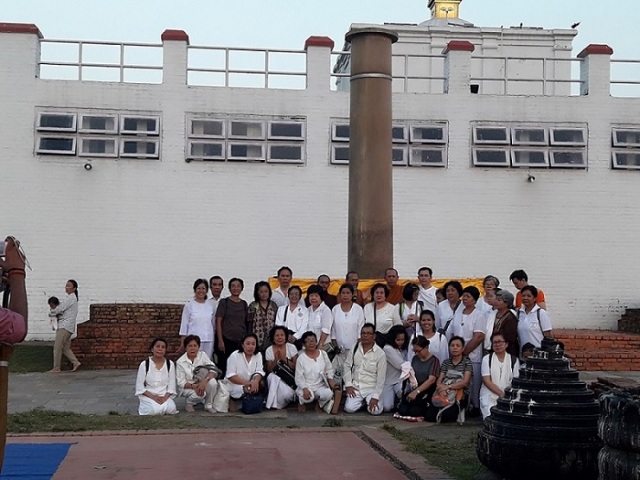 |
| A group of people taking a snap at the Ashoka pillar. Photo: LB Thapa |
By LBTHAPA, in Lumbini
(This article was originally published
in The Rising Nepal)
Going back into the history, Lumbini was left in oblivion for centuries. Muslim invaders who ruled over India for several years were not kind enough to other religions. Different Muslim invaders went on rampage and destroyed several Hindu temples and Buddhist monasteries across the length and breadth of India. Several broken idols of Hindu gods & goddesses and Lord Buddha are the testimony to the fact that Muslim invaders were extremely intolerant and ruthless against other religions.
Had Indian Emperor Ashoka not visited Lumbini and erected a stone pillar with inscription, commemorating the birth of Gautam Buddha in Lumbini in 248 BC, it would be extremely difficult for the archaeologists to determine the exact birthplace of Lord Buddha. Xuanzang, a Chinese monk, who visited Lumbini in 637 BC, had written extensively about his visit to India. He had even translated several Buddhist scriptures into the Chinese language. Fortunately, those scriptures are still survived in China.
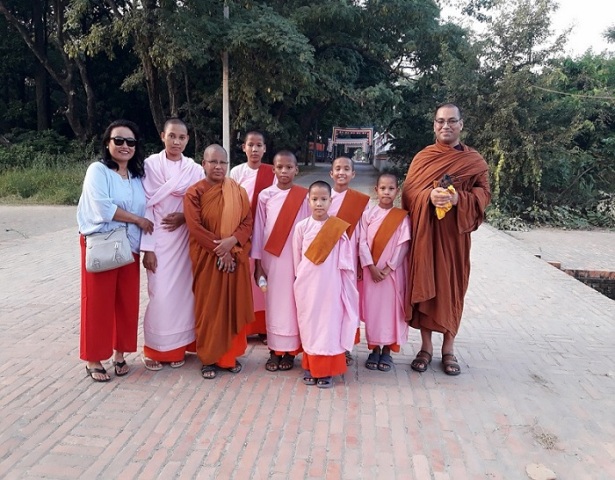 |
| A group of monk from Thailand. Photo: LB Thapa |
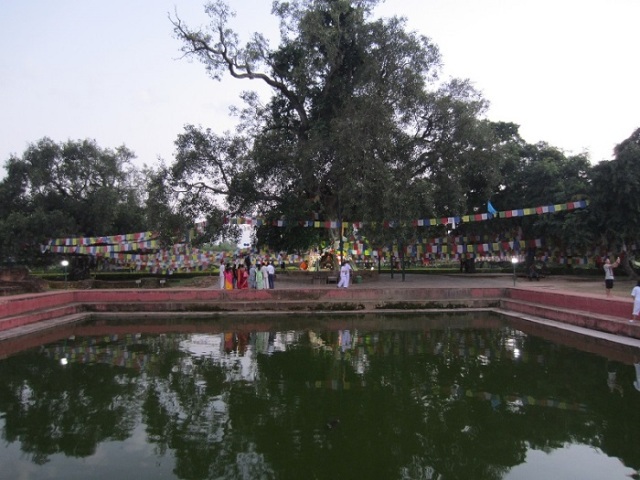 |
| The sacred pond beside Mayadevi temple. Photo: LB Thapa |
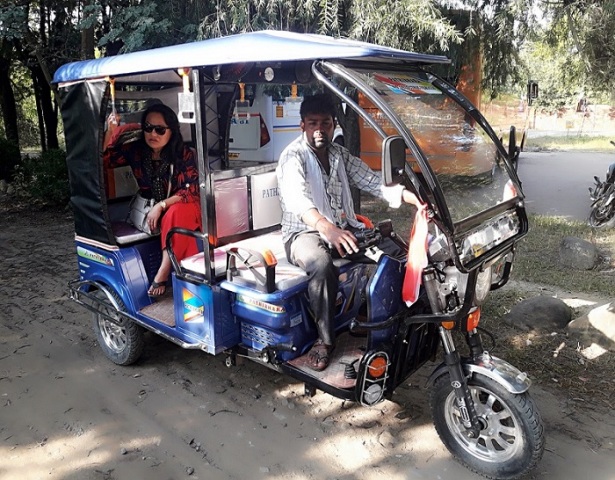 |
| A tourist boards a battery powered riksha for a Lumbini sightseeing. Photo: LB Thapa |
Alois Fuhrer, a German archaeologist, had rediscovered Lumbini in 1895. He is credited to have discovered Ashoka pillar and a temple at the location. A number of excavations were carried out and in the course of time, many Buddhist structures were rediscovered. Today, the entire area of Mayadevi temple has been rediscovered along with the exact birth marker stone of Lord Buddha in 1996. A pond has also been restored where it is believed that Mayadevi and her newly born baby had a bath. In the meantime, it was of course a big day when Lumbini was granted World Heritage status by UNESCO in 1997.
This scribe noticed that many visitors looked skeptic when they saw an exact birthmark stone of Lord Buddha. How this is possible to be so sure about an exact spot where Lord Buddha was born centuries ago. Their curiosity seems right because Lumbini was virtually left in oblivion for centuries, then how it is possible to locate an exact spot of birth of Lord Buddha. This was really a tough task before the archeologists as well.
However, a careful study, with the help of modern technology, finally the archeologists became successful to locate an exact spot where Lord Buddha was born. During excavations, the archeologists discovered an older timber structure beneath the walls of recent brick walls, which was built during the Ashoka era. Radiocarbon dating of wooden postholes and stimulated luminescence dating of elements in the soil confirms regular human activity at a particular spot for a long period. That means this very spot was regularly worshiped by the devotees of Lord Buddha. Based on such evidences, archeologists have confirmed the same spot as the exact birthmark of Lord Buddha.
At present Lumbini Development Trust (LDT), which is an autonomous and non-profit making organization, is taking care of development and supervising activities. The Lumbini development activities are being carried out according to Lumbini Master Plan, which was initiated by the United Nations and Prof. Kenzo Tange in 1978. However, even after 39 years, development activities are going on at the snail pace.
It is not known that how much more time it will take to complete Lumbini Master Plan. However, the inside area of the Lumbini is magnificent, serene and aesthetically beautiful. The visitors should take off their shoes and shocks before entering the garden where Ashoka pillar, Mayadevi temple and the birthplace of Lord Buddha are preserved with great care. Many Buddhist devotees sit before the Ashoka pillar and pray while others stand beside the Ashoka pillar and get a photograph to preserve the memory for lifetime.
The entire area of Lumini is spread over 4.8km in length and 1.6km in width. The visitors can tour the area and see fabulous monasteries built by different countries. Among many beautiful monasteries, the monastery built by Germany is outstanding. A large pond right before the monastery is simply awesome.
At the same time, the visitors can hire a battery-powered riksha, or they can take their own vehicles to have sightseeing. However, to my dismay this scribe saw several luxury buses, jeeps, vans and motorbikes parked inside the Lumbini premises. The emission of carbon from those vehicles will definitely take a toll on the historical monuments of Lumbini. It is beyond my understanding that why the concerned authority of LDT has allowed carbon belching vehicles inside the Lumbini area.
Not only this, occasionally even large kitchens are set beside the monasteries where several dishes are cooked and served the guests. I personally witnessed all this going on there. To make things go bad to worse the government has also allowed several industries in the vicinity of Lumbini which regularly pollute the area. Unfortunately, some beggars irritate visitors by repeatedly asking for money. Most beggars stand at the main entrance of the monastery and ask money from visitors.
The LDT has yet not started a well-managed tour of Lumbini area. They should have a battery-powered van or bus, which should take the visitors and pilgrims for a Lumbini tour. It would be much better if a guide is accompanied the visitors and describing about the historical monuments of Lumbini. Very recently, this scribe met Kularaj Baral, managing director of Miracle Institute, Pokhara, who has just returned from Canada visit.
“It was my official trip to Canada where I was staying in Vancouver. One fine morning I went to visit Stanley Park, where we were asked to get into a large, horse-pulling chariot. I was surprised to get a wonderful chariot ride ---this was what I least expected in a city like Vancouver. About that time I remembered if a horse drawn chariot is possible in Vancouver then why not in Lumbini” he asked.
I agree with Mr.Baral. It would be better if LDT immediately stops all kinds of vehicles inside the Lumbini premises and introduce horse-pulling chariots and battery-powered micro vans instead. The visitors will have choice between a horse-pulling chariot and a battery-powered van to move around Lumbini. This facility is also necessary to stop any damaging effects of pollutions caused by vehicles.
Although inside area of Lumbini is being developed according to the Master Plan, the surrounding area of Lumbini faces poverty, scarcity and acute unemployment. The Ministry of Culture, Tourism and Civil Aviation has decided to work on a 10-year Master Plan to develop Lumbini as a pilgrimage hub and increasing the length of tourists stay. However, the plan does seem ok only in the paper. In reality, the local people of Lumbini live in poverty and their needs and demands are neither met nor heard by the government.
Hotel entrepreneurs also don’t look happy in Lumbini. Due to lack of infrastructure and effective tour packages, most tourists hardly spend a day in Lumbini. When asked to a tour operator in Bhairawa, he said, “Most of the tourists coming to Lumbini are brought by the Indian tour operators. Those tour operators first take tourists to Bodh Gaya, Sarnath and Kushinagar.
On the last leg of the tour, the visitors are brought to Lumbini and Kapilbastu, where they don’t stay more than one day. The ministry of tourism is aware of this situation but does not act responsibly. I think our government is afraid of making India angry. What to speak about our government---I felt so low when India put a trade embargo against Nepal, but our political leaders in power could not speak a word against Indian bully ”.
Moreover, due to lackluster attitude of the successive governments, the development activities of Lumbini are awfully slow. Although the Master Plan of the development of Lumbini had begun in 1978, even after 39 years the development works is going on at the snail pace. Even conflicts among the Buddhist sects and monks have also been blamed to create hitches.
The government must rise above the party politics and take the issue of Lumbini development with due seriousness. Development of the Lumbini pilgrimage site should not the only issue. The government must also think how the living standard of the local people who live around Lumbini can be uplifted. The local people’s participation in development activities and creating more job opportunities are utmost necessary. Without improving the living standard of the local people of Lumbini, a real development of Lumbini will never be possible.
Gautam Buddha International Airport
The story of Gautam Buddha Airport is no different from the development of Lumbini. The construction work of Gautam Buddha airport should have been completed in 2017; but it is still far from completion. At different developmental stage, corruptions have drastically slowed down the steady development of the project.
A severe dispute over payments and illegal appointment of subcontractor had halted the work for a long time. Now it is said that the airport will come into operation until 2019. Hotel entrepreneurs and the entire people of the region believe that the operation of Gautam Buddha International Airport will change the face of Lumbini.
However, all major projects in Nepal whether it is hydropower projects, Melamchi water supply, Pokhara International Airport and so on and so forth have been infected with corruption virus. In a situation like this many people are quite skeptic about the completion of Gautam Buddha International Airport even in 2019.
Gautam Buddha International Airport is the most important project for the people of this region. With the completion of the airport, Lumbini will be connected to the world directly. The pilgrims will not come to Lumbini via India, where they visit other Buddhist shrines before coming to Lumbini.
With the completion of the airport, inflow of Buddhist pilgrims will definitely soar to a great height. Hotels, lodges and restaurants will thrive and local people will be able to sell their products of touristic interest. Once the airport comes into operation, it will open up the window of job opportunities for people.
Most importantly many local resources will be exploited which were due to lack of a potent market not used before. Not only hotel entrepreneurs but also many farmers will find extended market for their vegetables, poultry products and so on. Such enhanced economic activities will definitely improve financial condition of the people in and around the Lumbini area.
This scribe does not want Gautam Buddha International Airport also meet a similar fate that Pokhara International airport has met. Much has been spoken and written about Pokhara Regional International Airport in media, but in reality, nothing has happened. The actual construction work of Pokhara Regional International Airport had begun in 1989.
Today even after 29 years, there is no airport in sight. In the course of time, many governments came and gone, but the construction of Pokhara Regional International Airport has not seen a light of the day. Political leaders always tried to influence people by their political rhetoric and gimmicks. I hope nothing like this will happen with Gautam Buddha International Airport and by 2019 the airport will come into commercial operation.
Thank you very much for reading this article. I hope you liked this article. I will be glad if you take little time and make a comment about this article. Your comment is highly appreciated.
However, a careful study, with the help of modern technology, finally the archeologists became successful to locate an exact spot where Lord Buddha was born. During excavations, the archeologists discovered an older timber structure beneath the walls of recent brick walls, which was built during the Ashoka era. Radiocarbon dating of wooden postholes and stimulated luminescence dating of elements in the soil confirms regular human activity at a particular spot for a long period. That means this very spot was regularly worshiped by the devotees of Lord Buddha. Based on such evidences, archeologists have confirmed the same spot as the exact birthmark of Lord Buddha.
At present Lumbini Development Trust (LDT), which is an autonomous and non-profit making organization, is taking care of development and supervising activities. The Lumbini development activities are being carried out according to Lumbini Master Plan, which was initiated by the United Nations and Prof. Kenzo Tange in 1978. However, even after 39 years, development activities are going on at the snail pace.
It is not known that how much more time it will take to complete Lumbini Master Plan. However, the inside area of the Lumbini is magnificent, serene and aesthetically beautiful. The visitors should take off their shoes and shocks before entering the garden where Ashoka pillar, Mayadevi temple and the birthplace of Lord Buddha are preserved with great care. Many Buddhist devotees sit before the Ashoka pillar and pray while others stand beside the Ashoka pillar and get a photograph to preserve the memory for lifetime.
The entire area of Lumini is spread over 4.8km in length and 1.6km in width. The visitors can tour the area and see fabulous monasteries built by different countries. Among many beautiful monasteries, the monastery built by Germany is outstanding. A large pond right before the monastery is simply awesome.
At the same time, the visitors can hire a battery-powered riksha, or they can take their own vehicles to have sightseeing. However, to my dismay this scribe saw several luxury buses, jeeps, vans and motorbikes parked inside the Lumbini premises. The emission of carbon from those vehicles will definitely take a toll on the historical monuments of Lumbini. It is beyond my understanding that why the concerned authority of LDT has allowed carbon belching vehicles inside the Lumbini area.
Not only this, occasionally even large kitchens are set beside the monasteries where several dishes are cooked and served the guests. I personally witnessed all this going on there. To make things go bad to worse the government has also allowed several industries in the vicinity of Lumbini which regularly pollute the area. Unfortunately, some beggars irritate visitors by repeatedly asking for money. Most beggars stand at the main entrance of the monastery and ask money from visitors.
The LDT has yet not started a well-managed tour of Lumbini area. They should have a battery-powered van or bus, which should take the visitors and pilgrims for a Lumbini tour. It would be much better if a guide is accompanied the visitors and describing about the historical monuments of Lumbini. Very recently, this scribe met Kularaj Baral, managing director of Miracle Institute, Pokhara, who has just returned from Canada visit.
“It was my official trip to Canada where I was staying in Vancouver. One fine morning I went to visit Stanley Park, where we were asked to get into a large, horse-pulling chariot. I was surprised to get a wonderful chariot ride ---this was what I least expected in a city like Vancouver. About that time I remembered if a horse drawn chariot is possible in Vancouver then why not in Lumbini” he asked.
I agree with Mr.Baral. It would be better if LDT immediately stops all kinds of vehicles inside the Lumbini premises and introduce horse-pulling chariots and battery-powered micro vans instead. The visitors will have choice between a horse-pulling chariot and a battery-powered van to move around Lumbini. This facility is also necessary to stop any damaging effects of pollutions caused by vehicles.
Although inside area of Lumbini is being developed according to the Master Plan, the surrounding area of Lumbini faces poverty, scarcity and acute unemployment. The Ministry of Culture, Tourism and Civil Aviation has decided to work on a 10-year Master Plan to develop Lumbini as a pilgrimage hub and increasing the length of tourists stay. However, the plan does seem ok only in the paper. In reality, the local people of Lumbini live in poverty and their needs and demands are neither met nor heard by the government.
Hotel entrepreneurs also don’t look happy in Lumbini. Due to lack of infrastructure and effective tour packages, most tourists hardly spend a day in Lumbini. When asked to a tour operator in Bhairawa, he said, “Most of the tourists coming to Lumbini are brought by the Indian tour operators. Those tour operators first take tourists to Bodh Gaya, Sarnath and Kushinagar.
On the last leg of the tour, the visitors are brought to Lumbini and Kapilbastu, where they don’t stay more than one day. The ministry of tourism is aware of this situation but does not act responsibly. I think our government is afraid of making India angry. What to speak about our government---I felt so low when India put a trade embargo against Nepal, but our political leaders in power could not speak a word against Indian bully ”.
Moreover, due to lackluster attitude of the successive governments, the development activities of Lumbini are awfully slow. Although the Master Plan of the development of Lumbini had begun in 1978, even after 39 years the development works is going on at the snail pace. Even conflicts among the Buddhist sects and monks have also been blamed to create hitches.
The government must rise above the party politics and take the issue of Lumbini development with due seriousness. Development of the Lumbini pilgrimage site should not the only issue. The government must also think how the living standard of the local people who live around Lumbini can be uplifted. The local people’s participation in development activities and creating more job opportunities are utmost necessary. Without improving the living standard of the local people of Lumbini, a real development of Lumbini will never be possible.
Gautam Buddha International Airport
The story of Gautam Buddha Airport is no different from the development of Lumbini. The construction work of Gautam Buddha airport should have been completed in 2017; but it is still far from completion. At different developmental stage, corruptions have drastically slowed down the steady development of the project.
A severe dispute over payments and illegal appointment of subcontractor had halted the work for a long time. Now it is said that the airport will come into operation until 2019. Hotel entrepreneurs and the entire people of the region believe that the operation of Gautam Buddha International Airport will change the face of Lumbini.
However, all major projects in Nepal whether it is hydropower projects, Melamchi water supply, Pokhara International Airport and so on and so forth have been infected with corruption virus. In a situation like this many people are quite skeptic about the completion of Gautam Buddha International Airport even in 2019.
Gautam Buddha International Airport is the most important project for the people of this region. With the completion of the airport, Lumbini will be connected to the world directly. The pilgrims will not come to Lumbini via India, where they visit other Buddhist shrines before coming to Lumbini.
With the completion of the airport, inflow of Buddhist pilgrims will definitely soar to a great height. Hotels, lodges and restaurants will thrive and local people will be able to sell their products of touristic interest. Once the airport comes into operation, it will open up the window of job opportunities for people.
Most importantly many local resources will be exploited which were due to lack of a potent market not used before. Not only hotel entrepreneurs but also many farmers will find extended market for their vegetables, poultry products and so on. Such enhanced economic activities will definitely improve financial condition of the people in and around the Lumbini area.
This scribe does not want Gautam Buddha International Airport also meet a similar fate that Pokhara International airport has met. Much has been spoken and written about Pokhara Regional International Airport in media, but in reality, nothing has happened. The actual construction work of Pokhara Regional International Airport had begun in 1989.
Today even after 29 years, there is no airport in sight. In the course of time, many governments came and gone, but the construction of Pokhara Regional International Airport has not seen a light of the day. Political leaders always tried to influence people by their political rhetoric and gimmicks. I hope nothing like this will happen with Gautam Buddha International Airport and by 2019 the airport will come into commercial operation.
Thank you very much for reading this article. I hope you liked this article. I will be glad if you take little time and make a comment about this article. Your comment is highly appreciated.
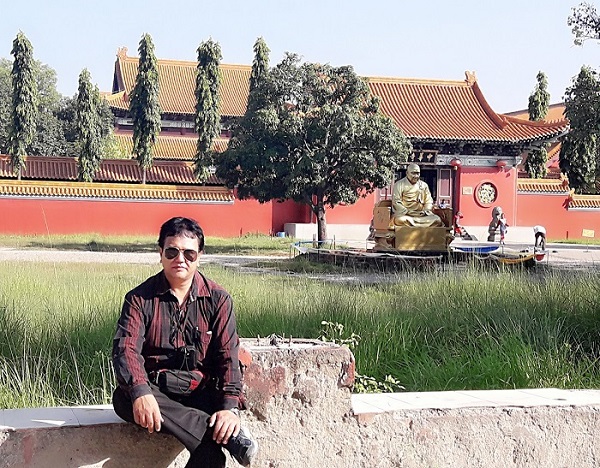 |
| LB Thapa is the publisher and editor of The Hemingway Post, a literary magazine. |
WANT TO REPRODUCE THIS ARTICLE?
All rights reserved. All the articles and
photos published in this blog are the copyright property of this blog. I allow
articles and photos to be reproduced only for information and educational
purposes. For that, you must mention the author and the blog's name. Blog: read2bhappy.blogspot.com. I would appreciate it if you inform me
by sending an email to writerlbthapa@gmail.com








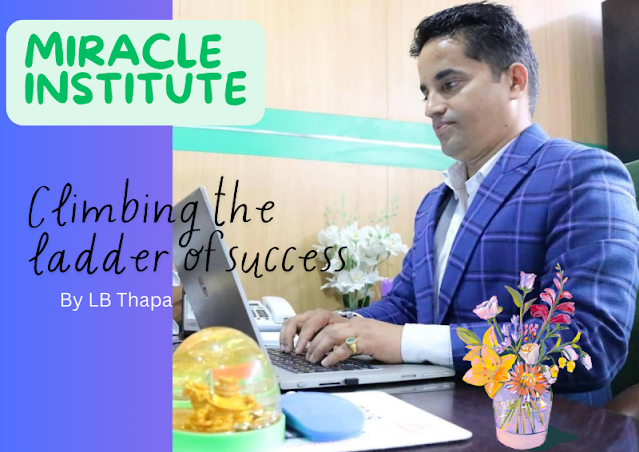

.png)
Comments
Post a Comment